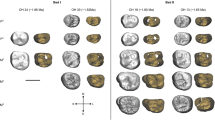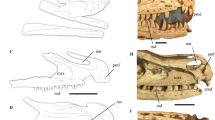Abstract
PROF. OSMAN HILL'S suggestion1 that the classification of the Hominidæ is in urgent need of revision is likely to meet with general agreement. It is doubtful, however, if the particular proposals which he puts forward will do more than deliver the question from its present confusion—a confusion which at least has the merit of attributing a glamorous if unreal diversity to human ancestry—into another confusion at least as great. This is certain to occur if the principles of zoological classification are as he defines them. The differences which he suggests indicate generic distinctions (“differences in external or internal structure”) cannot be regarded as essentially different from those which he believes to indicate specific distinctions (“differences in bodily proportions differences in bodily form”, etc.). For, quite apart from the verbal and logistic difficulty of deciding what is a difference in “structure” and what is a difference in “form”, there is strong reason for supposing that pronounced differences in the one or the other or both aspects of the body or its organs are often simply due to differences in growth-rates. For example, some monkeys have a vermiform appendix, others lack this structure. Osman Hill's criteria suggest that differences of this kind are necessarily a sign of generic distinction. The difference, however, is entirely dependent on a different pattern and rate of growth in the cæcal region of the large intestine, that is, on a process which in this case leads to an extreme difference in bodily proportions. These, however, Osman Hill regards as indicative of specific and not generic distinction. It would therefore seem that no real difference separates his criteria for denning genera and species. In any event it is difficult to see how they could be applied to fragments of fossil human skulls.
This is a preview of subscription content, access via your institution
Access options
Subscribe to this journal
Receive 51 print issues and online access
$199.00 per year
only $3.90 per issue
Buy this article
- Purchase on Springer Link
- Instant access to full article PDF
Prices may be subject to local taxes which are calculated during checkout
Similar content being viewed by others
References
Osman Hill, W. E., NATURE, 145, 260 (1940).
Regan, C. Tate., Rep. Brit. Assoc. Southampton, 1925 (1926).
Zuckerman, S., Eugenics Rev., 24, 1931 (1931).
Le Gros Clark, W. E., Modern Quarterly, 2, 115 (1939); also Presidential Address to Section H, Brit. Assoc. Advance Sci. (1939).
Von Koenigswald, G. H. R., and Weidenreich, F., NATURE, 144, 926 (1939).
Zuckerman, S., “Functional Affinities of Man., Monkeys and Apes” (London: Kegan Paul, 1933).
Arkell, W. J., and Moy-Thomas, J. A., in “The New Systematics”. Edited by J. S. Huxley. (Oxford University Press, 1940).
Black, D., Bull. Geol. Soc. China, 9, 7 and 97 (1930).
J. Roy. Anthrop. Inst., 68, 17 (1938).
Marston, A. T., J. Roy. Anthrop. Inst., 67, 339 (1937).
Author information
Authors and Affiliations
Rights and permissions
About this article
Cite this article
ZUCKERMAN, S. Human Genera and Species. Nature 145, 510–511 (1940). https://doi.org/10.1038/145510a0
Issue Date:
DOI: https://doi.org/10.1038/145510a0
Comments
By submitting a comment you agree to abide by our Terms and Community Guidelines. If you find something abusive or that does not comply with our terms or guidelines please flag it as inappropriate.



